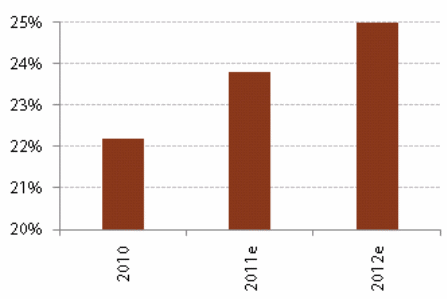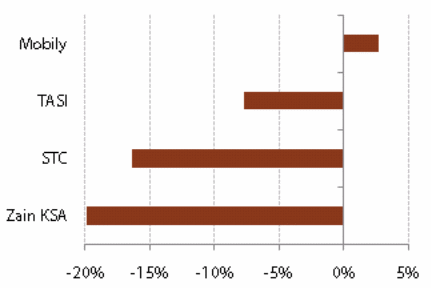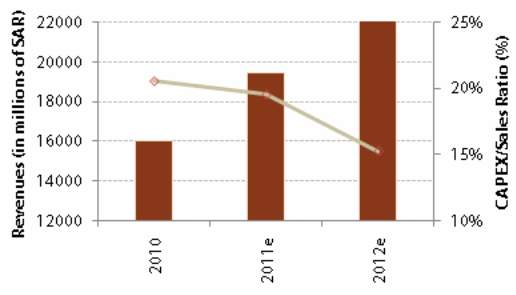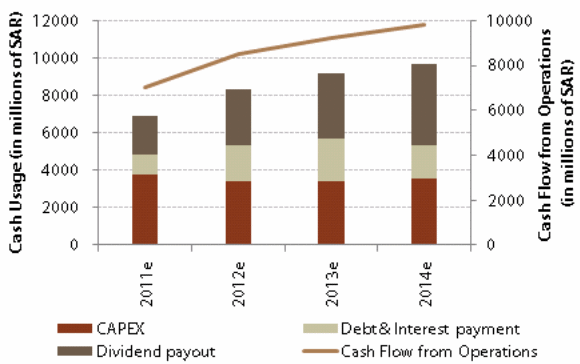Executive Summary
The telecommunications industry in Saudi Arabia has undergone tremendous change over the recent past. This paper focuses on three major stakeholders in the provision of telecommunication services in this region with more emphasis on Mobily Telecommunications Company.
The three main companies in operation within this region are Etisalat also called Mobily, the Zain telecommunications company owned by the Zain group in Kuwait, and the Saudi Telecommunication Company (STC). The later is the leader in both market share and penetration. At the end of last year, the telecommunications industry in the region grew by nine percent.
This is a region that exhibits tremendous increase in the number of mobile phone subscribers. The penetration of mobile phone use in this region is more than 200 percent reflecting the presence of many prepaid subscribers in the region.
Among the strategies that will likely have a big impact on the market is the shift to deductions for majority of the inactive subscribers. As indicated by changes in market strategies by these companies, this is a move feared to result into a drop in the number of subscribers and a decrease in the mobile phone penetration. This report examines the industry at the moment with regard to more than 52 million subscribers.
Among the strategies employed by these three companies is the introduction of 3.5 G connectivity. The later was first driven by Mobily and at the moment, the rest of the companies are equally shifting toward the same technology. Of the three companies, Mobily is the leading in operations and in innovations.
The devices used by Mobily exhibit the fasted download speed, and the company is currently testing the use of 42Mbps download speeds. The shift toward faster download speed by these service providers is expected to offer the market a big growth stimulus.
While examining the three companies in this report, the strategies employed by Mobily will be compared to those used by its rivals. The corporate strategies employed will be analyzed theoretically under both the SWOT and PEST analysis.
Background of Mobily Telecommunications Company
Mobily has been described as the fasted growing company in both Saudi Arabia and parts of North Africa. In Saudi Arabia, Mobily is the second largest telecommunications company. Also called Etihad –Etisahat, this company was founded by the Emirates Telecommunications Corporation based in UAE. The company plunged into Saudi Arabia in 2004.
Following its successful entry into the region, the company adopted a fast growing strategy with regard to both direct and indirect channels for selling its services (Audi Saradar Investment Bank, 2011). This is a strategy that allowed this company to attain rapid growth in the following years. It had nearly five million subscribers as at 2006 and later attained a subscription of six million by the following year.
Having won the bid for the GSM license, the company provides nationwide mobile phone services and is credited for breaking the monopoly in the industry. Mobily incorporated the use of 3.5G in 2006, and later adopted 4G services this year. The company is owned by a UAE consortium that holds 27 percent of the shares.
About 45 % of the shares of this company are held by six different local partners with the public owning 20 % following an IPO. The move to go public was a great success in 2008, and the IPO was evidently oversubscribed. This subsequently increased the company’s capital to nearly seven billion in Saudi Arabian currency. Later the same year, the company managed to acquire Bayanat Al Oula and Zaji International.
The two are major data service providers in the region. The company is greatly optimizing its costs via the acquisition of nearly 70 % of the shares of the Saudi National Fiber Network. The acquisition of this service provider has subsequently replaced the overdependence on the international gateway network.
At the moment, the company has successfully adopted a push to talk service also known as Mobily Hawwel, which offers users a different experience in service delivery. The adoption of 3G services is thus an added advantage when using this new feature (BMI, 2011). At the end of last year, the company had attained a 38 percent share of the market with nearly 20 million subscribers.
The company adopted the TD-LTE, a 4 G-based service in September this year and was ranked the first company in the region to adopt the use of this service. The company continues to invest in new technologies to foster customer satisfaction and is currently leading in innovations.
It is the first company to have adopted the blackberry services alongside the iPhone. Among the mobile phone operators in the region, Mobily was the first to adopt value added services such as roaming and the use of the location-based services (David, 2010).
Strategy Formulation
At the moment, the company continues to foster efforts geared at meeting customer demands and increasing the demand for its services. The successful adoption of the 4G services placed the company in the lead position in innovations. Among its plans for the future is to cover more than 85 % of the population in the region in three phases (Audi Saradar Investment Bank, 2011).
The company is already increasing its dominance in the market share with more than 75 % and a penetration rate of about 18 percent. The leadership of the company in the industry will highly be sustained by the adoption of the 4G services (David, 2007). The increase in connectivity speed is expected to generate more revenue for the company and at the same time provide both lower latency and cost efficiency.
The company is looking forward to providing its customers with a three months free subscription. This will equally benefit the customers by providing them with high speed services at competitive prices. According to the management, this strategy will foster customer loyalty. With the adoption of the 4G services, the company expects to meet fierce competition among its rivals that are equally shifting toward the same technology.
SWOT Analysis
Opportunities
Mobily telecommunications enjoys a good market opportunity for its products and services. The deployment of the 4G service is expected to amount into more client wins. The company enjoys a large support for growth in digital EPS. At the end of this year, STC, and Mobliy are looking forward to an agreement on infrastructure sharing.
This will be done by laying off towers as separate entities hence becoming more convenient. With the completion of this agreement, it is expected that the industry will provide high economies of scale within the region.
Mobily will highly benefit from this arrangement, especially with its high penetration into the local market coupled with its small size. It is equally expected that savings from OPEX will subsequently subdue expenditures in capital that will lead into more cash saving.
The company is characterized by high dividends and protection from economic volatilities. The dividends policy is expected to rise to 5.6 % in the course of next year. This margin is very favourable for the company especially in the wake of its growth prospects.
It is equally expected that the company will be able to effectively reimburse its debt in time. Generally Mobily enjoys great demand for its services, especially in the broadband category. At the moment, there exists a very large addressable market that the company can plunge into within the Saudi region that equally offers very ideal demographics.
Strengths
Unlike any of its rivals, Mobily is in a better position to highly benefit from the growth of the data segment within the Saudi Arabia region. Because the company has a very high dominance on the local market within the region, the use of the Saudi only approach offers fewer risks and avoids currency-related problems.
The company equally exhibits very strong cash flow that enables it to provide relatively high dividends and subsequently attract more investors. With the adoption of the 4 G services coupled with the just concluded move to partner with Google, Mobily is well placed to provide the highest support in both computing and mobile phone services.
The company has now successfully acquired big tickets within the market. For instance, Mobily was chosen by SAIBC for the IP VPN project. The company was also considered by General Organization for Social Insurance (GOSI) in the Wahat Ghurnatah business park project (BMI, 2011). As at the end of last year, the company had 10 % of its revenue in corporate revenue which was 60 % lower than the European leverage.
The management of this company has for the recent past managed to allocate capital investments with increase in the returns of the capital. It is expected that the trends will continue into the coming years and provide more value for investors by widening the gap between (ROIC) and the weighted average cost (WACC). The figure below depicts Mobilys’ (ROIC).

(Mintzberg et al., 2003).
The company expects to increase its cash flows by 12 %. This implies a progressive increase in dividend payouts in the future. The company is guiding a 40 % payout in dividends this year and will reward its investors in the future with relatively high dividends than in preceding years.
The yield in dividends is expected to be at 7.9 percent at the conclusion of this year. The internally generated revenue is expected to take care of the CAPEX requirements and repay both interests and debts. The company also expects to effectively distribute enough dividends to its investors from internally generated revenue.
Weaknesses
At the moment, Mobily has not managed to attain a large market share because of the inability to outdo its arch rival STC. The entire broadmarket market in Saudi Arabia is highly dominated by STC. Following the penetration into the corporate segment, the company has also been experiencing a decline in the margins of the EBITDA (Audi Saradar Investment Bank, 2011).
Though the company expects a three year EPS CAGR of about 10 % more than that of STC, the company still trades at an 18 % discount. This is with regard to the PE figures depicted this year that is not fair given its growth prospects.
With the financial and the geo political events of this year, there was a fall in the equity markets. The defensive measures taken by Mobily are still evident in the wake of such circumstances. The figure below depicts its price performance when compared to its rivals.

(Mintzberg et al., 2003).
Threats
The main challenge for Mobily is the stiff competition from new and existing market stakeholders. The entire broadmarket in the region is dominated by very stiff and irrational competition coupled with unfair tariff wars (Audi Saradar Investment Bank, 2011).
The company is equally subjected to very unfriendly regulatory changes. Like any other operator in the market, Mobily is equally at the risk of the constrains caused by the financial and geo-political events within the MENA region. Of the threats, fierce competition in the telecommunication industry with the region is the most risky.
The use of the Internet in mobile phone services is equally increasing within the region with each company adopting enabling technologies. This is escalated by the high demand for international phone services among expatriates living in the region. STC a major rival has on most occasions attempted to block service delivery via Internet protocol services like Skype.
External Analysis of Competitors: STC and ZAIN
STC is the leading company in the telecommunications industry in Saudi Arabia. Unlike Mobily, this company has a bigger market share and penetration rate. STC offers both landline and mobile phone services and also provides excellent internet services (BMI, 2011). This company poses the greatest threat to Mobily because it was the first to adopt the use of 4 G services and also the first to get an operating license.
The company offers the best value added services such as the Jawal for tracking kids and the Aeromobile for flight travelers. This makes it possible for STC to enjoy the biggest customer loyalty compared to Mobily. It is evidently impossible for STC to loose any of its subscribers to either Mobily or Zain. However, because of the greater advantage offered to customers in STC, Mobily risks loosing some of its customers to STC.
STC therefore tends to increase the bargaining power of buyers for Mobily and subsequently increases the power of substitute services. The company also bits Mobily by offering the best volume discounts and PPT services. STC is always ahead of Mobily in not only market share but also in value added technologies. This is the company that tends to pose the highest competition for Mobily in the market.
This is because it operates dominantly on the same local market with Mobily. The company records the highest revenue and profits and it is in a better position to meet competition and any financial wrangles than Mobily.
Zain
Unlike STC, Zain poses a lesser risk of competition to Mobily. This is because this company is facing problems related to its ownership. Apparently, Mobily plans to acquire a large percent of its shares. This will be an added advantage for Mobily because it will increase its market share by acquiring Zain’s share of the market.
Because it is still not clear when the ownership wrangles would be resolved, the ownership of this company remains unchanged. This explains why the company is struggling to survive in the market because it lacks proper management strategies to enable it to compete with both STC and Mobily. The company also exhibits the lowest rate of growth and penetration in the Saudi region (BMI, 2011).
Of the companies in the telecommunications industry in Saudi Arabia, ZAIN poses the least competition to Mobily. With regard to the Porter’s five forces model, Zain poses a less impact on the bargaining power for buyers for Mobily (Porter, 1998). Because the services offered by Mobily are better than those offered by Zain, the power of substitutes posed by Zain is negligible.
PEST Analysis
The operations of Mobily in the Saudi Arabia region highly depend on the prevailing political climate. Because it is a dominantly local company, Mobily is less affected by changes in international trade regulation (BMI, 2011). The company is however, greatly affected by changes in monetary policies, inflation levels, and the trends in the growth of the economy.
These economic factors tend to affect the demand for its products and services. With regard to technology and innovation, the company takes the lead role and thus highly depends on the technological environment. The operations of this company are highly determined by changes in speed and general information transfer.
New technology advances especially by any of the rival companies may subsequently affect the operations of Mobily on the same market (David, 2007). This explains its struggle to lead in technology and innovations.
Strategy Implementation
As indicated by Mintzberg et al. (2003), globalization requires the choice of appropriate strategies among firms. Mobily, STC, and Zain face the same challenges in the industry but the integration of each company into the market defines the difference. Mobily has chosen to differentiate itself from its rivals through its services and products.
The company highly focuses on the demand of the people on the local market through its service provision. Being a multidomestic company, the company faces tough market and technology conditions. The company highly uses the Porter’s five force model to attain a competitive advantage in the market (Porter, 1998).
This is a strategy that guards against the entry of rivals, the bargaining power of suppliers, the bargaining buyer of buyers, the threat of substitutes, and competition among existing companies. Mobily highly integrates this strategy in the localization of its products for the Saudi market.
Key among its developments is the shift to increase its connectivity using fast speed services. Besides concentrating on the local market, Mobily has also ventured into the international market with operations in North Africa.
The management at Mobily has equally effectively allocated investments with the increase in the (ROIC). This is expected to yield more value for its investors in the future. The figure below depicts the company’s revenues and the CAPEX ration.

(Mintzberg et al., 2003).
Cash flow from its operations as predicted in the next three years is relatively assuring. The company is thus in a good position to manage its debts, pay dividends, and its interests. The figure below depicts the flow of cash in the operations of this company (David, 2010).

(Mintzberg et al., 2003).
Strategy Evaluation
Following its key development in increasing connectivity via the use of fast speed services, Mobily is at the moment examining the possibility of incorporating the next fastest speed service. The move to use fast connectivity by this company is expected to offer very fast download speed for the Saudi Arabia subscribers.
Services being offered by this company have highly contributed to the transformation of the broadband subscription in the region (Audi Saradar Investment Bank, 2011). Mobily has already started preparing for the next generation in mobile phone technology.
This is indicated by the shift toward the so called Long Term Evolution (LTE). The company plans to partner with various service providers such as Google and Nokia to effectively deploy the LTE Network in the region. With regard to the SWOT analysis, the company has proposed the need to shift to collaborations with other stakeholders to foster a powerful competitive advantage.
The company identifies that a very strong base in technology and innovations is needed. The collaborations with any stakeholders are thus geared at addressing gaps in technology.
The company began the first quarter of this year’s financial period with a 40 % increase in net profit. This made a huge impact that outweighed many expectations. The company is looking forward to improving its service provision by increasing wireless communication and incorporating fast data services.
Conclusion
The above analysis provides an overview of the strategies adopted by Mobily Telecommunications Company in Saudi Arabia. Because of the stiff competition in the region, innovation and the adoption of the latest technology has greatly helped this company to maintain its place in the market.
The company recognizes that the use of new products and the shift toward globalization are key strategies that would help it to stay on top of the competition. With the existence of the three companies on the same market, it is relatively hard for either of the companies to attain full dominance of the market.
However, STC enjoys a relatively large share of the market compared to both Mobily and Zain. In fact, Mobily is ranked second after STC with regard to both market share and penetration in the region. Mobily has attained tremendous success in the region following its launch and was recently confirmed as the best company in the telecommunications industry in the region.
This confirmation was done by the Arabian Business monthly magazine that awarded the prize to Homoud Al –Ghobaini on behalf of the company. The company is currently working toward international recognition via globalization. This will ensure better profits and at the same time earn the company a competitive advantage.
References
Audi Saradar Investment Bank. (2011). Etihat Etisalat-Mobily. Equity Research, pp.1- 10.
BMI. (2011, July 19). Saudi Arabia Telecommunications Report. Business Monitor International, p.81.
David, F. (2007). Strategic Management: Concepts and Cases. London: Pearson Prentice Hall.
David, F. (2010). Strategic Management: Concepts (13th ed.). New Jersey: Prentice Hall.
Mintzberg, H., Lampel, J., Quinn, B., & Ghoshal, S. (2003). The Strategy Process: concepts, contexts and cases (4th ed.). London: Pearson Education.
Porter, M. (1998). Competitive Strategy: Techniques for Analyzing Industries and Competitors (1st ed.). New York: Free Press.